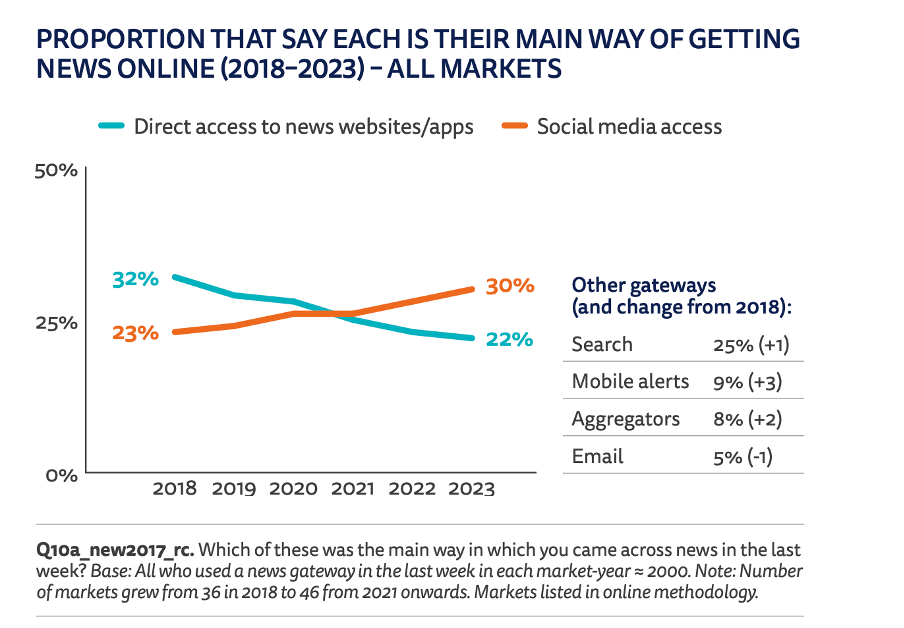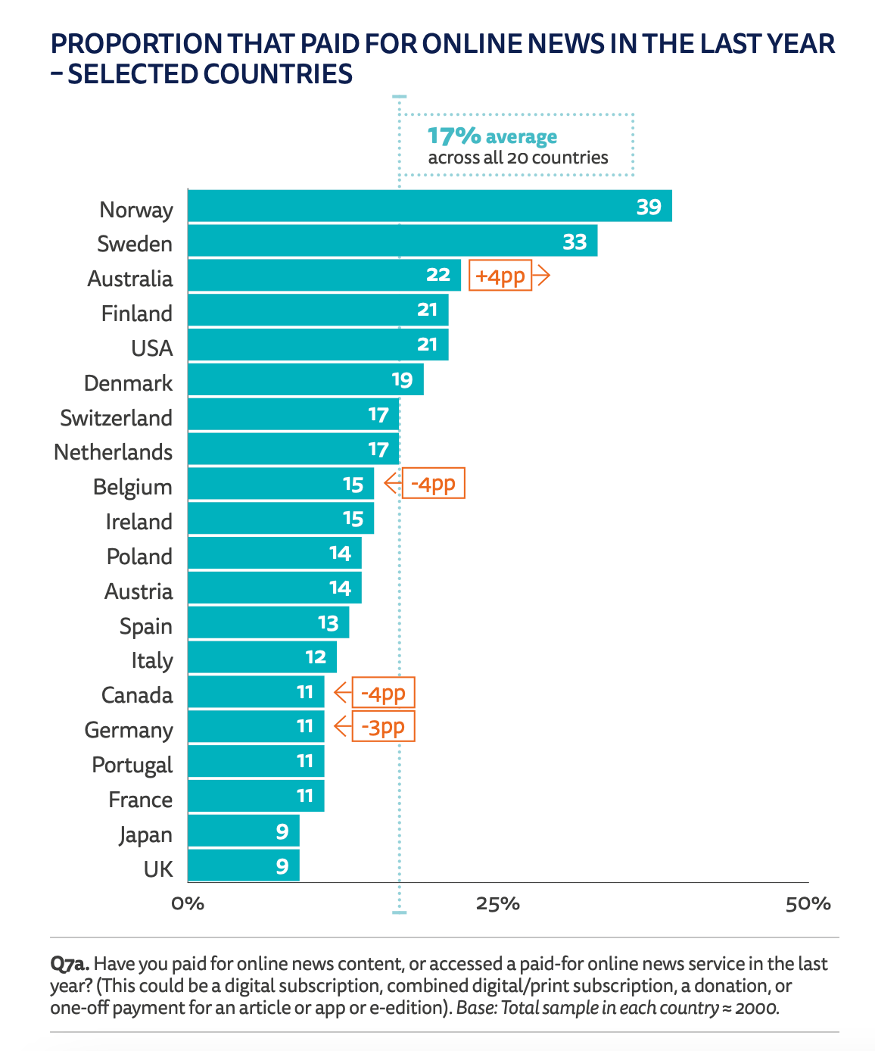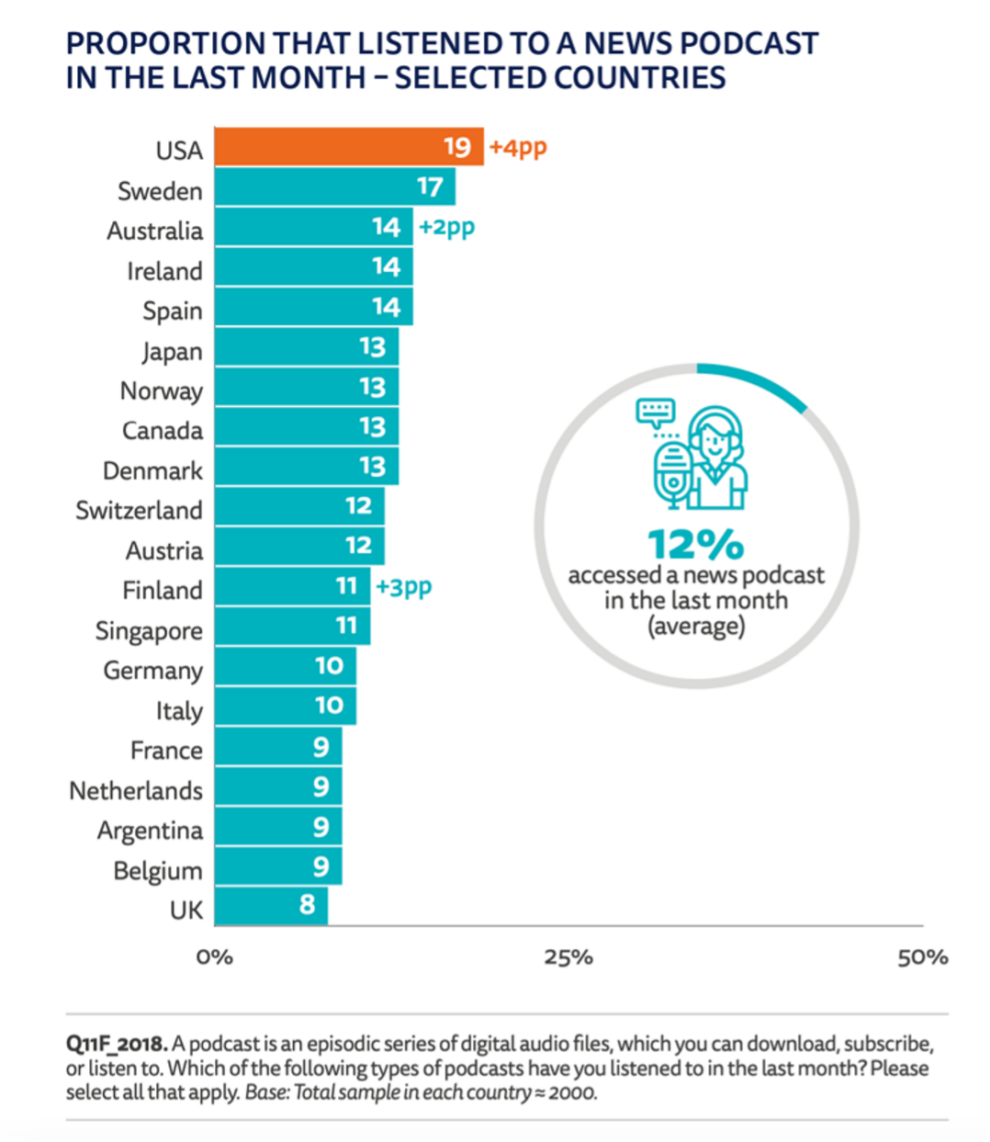Blog
10 charts from the Reuters Digital News Report 2023
Reuters unveiled its highly anticipated 2023 Digital News Report yesterday. This comprehensive study delves into the intricacies of news consumption around the globe, providing invaluable insights into the evolving landscape of information dissemination. Join us as we navigate the highlights of the report, exploring the ever-changing dynamics of news consumption in the digital era.
Beyond the tipping point for direct access
We see more and more people using social media as their main access point into the news, rather than coming direct via news websites and apps.

Back in 2021 we reached the tipping point where social media access overtook direct access for the first time and now that trend continues into 2023. Interestingly, Nordic countries are bucking the trend and continue to have a much more direct consumer relationship than most other markets.
Not at all surprising is that we also see big differences between age groups, with younger audiences predominantly driving the trend to access news via social media. These so called ‘social natives’ (18-24 year olds) who grew up with social media as part of their lives, remind us that publishers are in a constant battle to engage younger audiences, which will only get harder over time.
Join our Digital Growth Summit on September 26th in Brussels where we’ll discuss in depth the topic of engaging audiences from different generations.

As Facebook switch their focus away from journalism, it makes sense that we see declining news access via the platform. TikTok however is a very different story, with 20% of 18–24-year-olds using the platform for news.
Threat: with an increasing influx of digital natives in the category 18-24 and up until 35yo, and a shifting news reading behaviour, publishers should be more and more concerned with how to become relevant for these news consumers or they risk to face a shrinking audience in the years to come
It’s clear that publishers will need to meet these younger audiences where they are and produce content directly for those platforms. With TikTok beginning to roll out monetization for publishers via their new ad product, there is likely to be opportunity in the coming years with the platform.
Willingness to pay remains steady
For the past several years the report deep dives into audiences’ willingness to pay for news in different markets. From the 20 countries surveyed the average proportion making any online news payment remains at 17% for the second year running. Good to see that the subscribers acquired during the covid bump being retained.

In the US more than half of subscribers (56%) pay for 2 of more news subscriptions, often a national title and either a local news title or a niche title or magazine (think The Athletic, New Yorker…). There are only 3 other countries from those surveyed (Australia, Spain, France) who have a median subscription number higher than 1.

When it comes to subscribing to a foreign title, Ireland takes the lead (48%), with Canada (39%) and USA (22%) trailing behind. Both Ireland and Canada’s foreign subscription focus is, unsurprisingly, on the New York Times.
Interestingly, in a trend we see mostly confined to the US, 8% of subscribers pay for a newsletter written by a journalist or influencer and 5% pay for a podcaster or YouTuber. We expect to see these percentages grow within and outside of the US in future reports.
We heard back at Digital Media Europe how important it is for publishers to put real personality and authenticity into their social content if they want to connect with younger audiences. In a recent example of the power of personalities, cable news ratings show that in the two weeks since the Tucker Carlson was fired, figures for Carlson’s former spot have dropped by around 50 percent, while the network’s audience among 25-to-54-year-olds had shrunk by two thirds.
Distinctive content is the top reason for subscribing

The main reason that survey respondents subscribe to news services is cited as the ability to access better quality or more distinctive journalism. (51% average, 65% in the US). Another reason to pay in which the US results higher than other countries is to help fund good journalism.
Germany in particular sees a lack of people subscribing because they identify with the brand and its politics, both important reasons for subscribers in the US and the UK.
Finally, we see that puzzles, games and non-news related features also have an impact and are very important topics for many subscribers.
On the flip side of the coin, the main reason that people cited for cancelling or not taking subscriptions is the on-going cost of living crisis. The older and less price-sensitive subscribers have much less chance to churn, whereas younger audiences are constantly reassessing value and searching for the best deals.

As many as 65% in the UK and 54% in Germany of non-payers surveyed said that nothing could convince them to pay for a news subscription, which shows the general level of disinterest in this group.
Overall, it seems that the best chance to acquire new subscribers lies in reduced prices and more flexibility for people who don’t want to be tied into one brand and prefer to cherry pick the content that appeals to them. Perhaps this is the time to re-open the micropayments debate with the social native audience?
Only 13% of non-payers said they could be convinced by an ad free experience, which goes to show that ad and subscription revenue could work in harmony (with the right ad experience!)
Be ready to tailor content to younger generations
18–24-year-olds prefer to watch or listen to the news, much more than the older groups. Of-course this links to the social-native’s preference for consuming news via video focused social platforms like TikTok.

As highlighted in the report Foreword, we can’t expect the younger generations to grow up and change their preferences, so news publishers must adapt to survive and capture these new growing audiences.
There are no reasonable grounds for expecting that those born in the 2000s will suddenly come to prefer old-fashioned websites, let alone broadcast and print, simply because they grow older.
Prof. Rasmus Kleis Nielsen (Director, Reuters Institute)
News podcast use stable as overall podcast market grows
Since 2018 the Reuters survey has tracked podcast use in 20 countries with a well-developed podcast industry. News podcast usage has grown from around 1/4 to 1/3 in that time, but these podcasts still compete against all manner of other podcast content. On average, 12% of respondents accessed a news podcast in the past month.
Podcasts have a growing audience and crucially, their audience is typically younger, better educated, richer, and able to fit podcasts into their lives whilst doing other things.
It seems that ‘extended chat’ type podcasts gain the most audience attention across the countries surveyed, these podcasts can also be of particular interest to publishers as they are relatively cheap and easy to produce.

Excluding the super-large podcasts like The Daily (from the New York Times) and Genstart from Danish Radio, most news podcasts have a limited audience which can make monetization through advertising very difficult. For most smaller publishers (and I mean smaller than the New York Times), think about using podcasts to engage a younger audience and build a deeper relationship with them, rather than looking through an monetization lens (for now). Back in February we shared how 72% of publishers planned to invest in audio in 2023.

People are worried about over-personalisation

Almost half of all surveyed participants across all countries stated that they were worried about personalisation and algorithmic selection of articles for two main reasons: missing important information and missing challenging viewpoints.
Despite the obvious worry here, the chart shows us that the level of concern has reduced slightly since 2016. The level of worry also extends out of personalisation and into journalistic selection, with the results showing that if somebody is worried about one, they are very likely also worried about the other.
Personalisation tools must keep in mind the importance of algorithms that avoid filter bubbles and echo chambers. For example, our own JAMES personalisation technology blends fully personalised content with top trending content, whilst keeping editors in the loop to help alleviate these concerns.
It’s clear that the majority of news publishers continue to face the challenge of catering for the widely different expectations of news readers from different ages groups and demographics.
You can see Nic Newman, lead researcher of the Reuters Digital News Report, at our upcoming Digital Growth Summit event in September. Early bird tickets expire at the end of June.
Other Blog Posts

Stay on top of the game
Subscribe to Twipe’s weekly newsletter to receive industry insights, case studies, and event invitations.
"(Required)" indicates required fields

